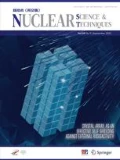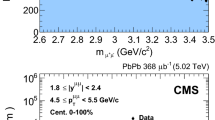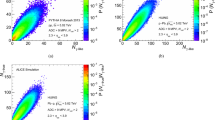Abstract
The Ω and ϕ production in relativistic heavy-ion collisions is studied in a dynamical quark coalescence model using the phase space information of strange quarks from a multiphase transport (AMPT) model. Enhanced local parton density fluctuation is implemented in the AMPT to simulate the QCD phase transition dynamics. By studying the transverse momentum \(p_{\rm T}\) spectra and the elliptic flow of the multi-strangeness particles, such as Ω and ϕ, and the \(\Omega /\phi \) ratio as a function of \(p_{\rm T}\) in the AMPT, we find that the new development improves the description of experimental data. The study motivates further experimental investigations of Ω and ϕ production in phase II of the Beam Energy Scan program at RHIC.





Similar content being viewed by others
References
M.M. Aggarwal et al., arXiv:1007.2613
Y. Aoki, G. Endrodi, Z. Fodor et al., The order of the quantum chromodynamics transition predicted by the standard model of particle physics. Nature 443, 675 (2006). https://doi.org/10.1038/nature05120
P. de Forcrand, O. Philipsen, The QCD phase diagram for small densities from imaginary chemical potential. Nucl. Phys. B 642, 290 (2002). https://doi.org/10.1016/S0550-3213(02)00626-0
Z. Fodor, S.D. Katz, Critical point of QCD at finite \(T\) and \(\mu \), lattice results for physical quark masses. J. High Energy Phys. 4, 50 (2004). https://doi.org/10.1088/1126-6708/2004/04/050
G.Y. Shao, X.Y. Gao, Z.D. Tang et al., QCD phase diagram with the improved Polyakov loop effective potential. Nucl. Sci. Tech. 27, 151 (2016). https://doi.org/10.1007/s41365-016-0152-0
L. Adamczyk et al. (STAR Collaboration), Energy dependence of moments of net-proton multiplicity distributions at RHIC. Phys. Rev. Lett. 112, 032302 (2014). https://doi.org/10.1103/PhysRevLett.112.032302
L. Adamczyk et al. (STAR Collaboration), Beam energy dependence of moments of the net-charge multiplicity distributions in Au + Au collisions at RHIC. Phys. Rev. Lett. 113, 092301 (2014). https://doi.org/10.1103/PhysRevLett.113.092301
L. Adamczyk et al. (STAR Collaboration), Energy dependence of \(K\pi \), \(p\pi \) and \(Kp\) fluctuations in Au + Au collisions from \(\sqrt{s_{_{\rm NN}}}\) = 7.7 to 200 GeV. Phys. Rev. C 92, 021901(R) (2015). https://doi.org/10.1103/PhysRevC.92.021901
X.F. Luo, N. Xu, Search for the QCD critical point with fluctuations of conserved quantities in relativistic heavy-ion collisions at RHIC. Nucl. Sci. Tech. 28, 112 (2017). https://doi.org/10.1007/s41365-017-0257-0
J. Steinhermer, J. Randrup, Spinodal density enhancements in simulations of relativistic nuclear collisions. Phys. Rev. C 87, 054903 (2013). https://doi.org/10.1103/PhysRevC.87.054903
J. Steinhermer, J. Randrup, V. Koch, Non-equilibrium phase transition in relativistic nuclear collisions: Importance of the equation of state. Phys. Rev. C 89, 034901 (2014). https://doi.org/10.1103/PhysRevC.89.034901
F. Li, C.M. Ko, Spinodal instabilities of baryon-rich quark-gluon plasma in the Polyakov–Nambu–Jona-Lasinio model. Phys. Rev. C 93, 035205 (2016). https://doi.org/10.1103/PhysRevC.93.035205
C.M. Ko, F. Li, Density fluctuations in baryon-rich quark matter. Nucl. Sci. Tech. 27, 140 (2016). https://doi.org/10.1007/s41365-016-0141-3
F. Li, C.M. Ko, Spinodal instabilities of baryon-rich quark matter in heavy ion collisions. Phys. Rev. C 95, 055203 (2017). https://doi.org/10.1103/PhysRevC.95.055203
K.J. Sun, L.W. Chen, C.M. Ko et al., Probing QCD critical fluctuations from light nuclei production in relativistic heavy-ion collisions. Phys. Lett. B 774, 103 (2017). https://doi.org/10.1016/j.physletb.2017.09.056
L. Adamczyk et al. (STAR Collaboration), Beam-energy dependence of the directed flow of protons, antiprotons, and pions in Au + Au collisions. Phys. Rev. Lett. 112, 162301 (2014). https://doi.org/10.1103/PhysRevLett.112.162301
S.V. Afanasiev et al. (NA49 Collaboration), Energy dependence of pion and kaon production in central Pb + Pb collisions. Phys. Rev. C 66, 054902 (2002). https://doi.org/10.1103/PhysRevC.66.054902
C. Alt et al. (NA49 Collaboration), Pion and kaon production in central Pb + Pb collisions at 20\(A\) and 30\(A\) GeV: evidence for the onset of deconfinement. Phys. Rev. C 77, 024903 (2008). https://doi.org/10.1103/PhysRevC.77.024903
J. Adams et al. (STAR Collaboration), Scaling properties of hyperon production in Au + Au collisions at \(\sqrt{s_{_{\rm NN}}}\) = 200 GeV. Phys. Rev. Lett. 98, 062301 (2007). https://doi.org/10.1103/PhysRevLett.98.062301
B.I. Abelev et al. (STAR Collaboration), Energy and system size dependence of ϕ meson production in Cu + Cu and Au + Au collisions. Phys. Lett. B 673, 183 (2009). https://doi.org/10.1016/j.physletb.2009.02.037
B.I. Abelev et al. (STAR Collaboration), Observation of an antimatter hypernucleus. Science 328, 58 (2010). https://doi.org/10.1126/science.1183980
S. Zhang, J.H. Chen, D. Keane et al., Searching for onset of deconfinement via hypernuclei and baryon-strangeness correlations. Phys. Lett. B 684, 224 (2010). https://doi.org/10.1016/j.physletb.2010.01.034
P. Liu, J.H. Chen, Y.G. Ma et al., Production of light nuclei and hypernuclei at high intensity accelerator facility energy region. Nucl. Sci. Tech. 28, 55 (2017). https://doi.org/10.1007/s41365-017-0207-x
K. Hattori, X.G. Huang, Novel quantum phenomena induced by strong magnetic fields in heavy-ion collisions. Nucl. Sci. Tech. 28, 26 (2017). https://doi.org/10.1007/s41365-016-0178-3
J. Tian, J.H. Chen, Y.G. Ma et al., Breaking of the number-of-constituent-quark scaling for identified-particle elliptic flow as a signal of phase change in low-energy data taken at the BNL Relativistic Heavy Ion Collider (RHIC). Phys. Rev. C 79, 067901 (2009). https://doi.org/10.1103/PhysRevC.79.067901
L. Adamczyk et al. (STAR Collaboration), Observation of an energy-dependent difference in elliptic flow between particles and antiparticles in relativistic heavy ion collisions. Phys. Rev. Lett. 110, 142301 (2013). https://doi.org/10.1103/PhysRevLett.110.142301
L. Adamczyk et al. (STAR Collaboration), Centrality and transverse momentum dependence of elliptic flow of multistrange hadrons and ϕ meson in Au + Au collisions at \(\sqrt{s_{_{\rm NN}}}\) = 200 GeV. Phys. Rev. Lett. 116, 062301 (2016). https://doi.org/10.1103/PhysRevLett.116.062301
L. Adamczyk et al. (STAR Collaboration), Probing parton dynamics of QCD matter with Ω and ϕ production. Phys. Rev. C 93, 021903(R) (2016). https://doi.org/10.1103/PhysRevC.93.021903
J.H. Chen, F. Jin, D. Gangadharan et al., Parton distributions at hadronization from bulk dense matter produced in Au + Au collisions at \(\sqrt{s_{\rm NN}}\) = 200 GeV. Phys. Rev. C 78, 034907 (2008). https://doi.org/10.1103/PhysRevC.78.034907
Y.J. Ye, J.H. Chen, Y.G. Ma et al., Ω and ϕ in Au + Au collisions at \(\sqrt{s_{_{\rm NN}}}\) = 200 and 11.5 GeV from a multiphase transport model. Chin. Phys. C 41, 084101 (2017). https://doi.org/10.1088/1674-1137/41/8/084101
H. van Hecke, H. Sorge, N. Xu, Evidence of early multistrange hadron freeze-out in high energy nuclear collisions. Phys. Rev. Lett. 81, 5764 (1998). https://doi.org/10.1103/PhysRevLett.81.5764
A. Shor, ϕ-Meson production as a probe of the quark-gluon plasma. Phys. Rev. Lett. 54, 1122 (1985). https://doi.org/10.1103/PhysRevLett.54.1122
Y.C. He, Z.W. Lin, Improved quark coalescence for a multi-phase transport model. Phys. Rev. C 96, 014910 (2017). https://doi.org/10.1103/PhysRevC.96.014910
L.W. Chen, C.M. Ko, ϕ and Ω production in relativistic heavy-ion collisions in a dynamical quark coalescence model. Phys. Rev. C 73, 044903 (2006). https://doi.org/10.1103/PhysRevC.73.044903
C.M. Ko, Transport model studies of the baryon-rich quark-gluon plasma formed in heavy ion collisions. PoS CPOD 2009 (2009), p. 034. https://doi.org/10.22323/1.071.0034
Z.W. Lin, C.M. Ko, B.A. Li et al., Multiphase transport model for relativistic heavy ion collisions. Phys. Rev. C 72, 064901 (2005). https://doi.org/10.1103/PhysRevC.72.064901
A. Bzdak, G.L. Ma, Elliptic and triangular flow in \(p\)-Pb and peripheral Pb–Pb collisions from parton scatterings. Phys. Rev. Lett. 113, 252301 (2014). https://doi.org/10.1103/PhysRevLett.113.252301
Z.W. Lin, Evolution of transverse flow and effective temperatures in the parton phase from a multiphase transport model. Phys. Rev. C 90, 014904 (2014). https://doi.org/10.1103/PhysRevC.90.014904
Z.W. Lin, C.M. Ko, S. Pal, Partonic effects on pion interferometry at the relativistic heavy-ion collider. Phys. Rev. Lett. 89, 152301 (2002). https://doi.org/10.1103/PhysRevLett.89.152301
X.N. Wang, Role of multiple minijets in high-energy hadronic reactions. Phys. Rev. D 43, 104 (1991). https://doi.org/10.1103/PhysRevD.43.104
X.N. Wang, M. Gyulassy, HIJING: a Monte Carlo model for multiple jet production in pp, pA, and AA collisions. Phys. Rev. D 44, 3501 (1991). https://doi.org/10.1103/PhysRevD.44.3501
B. Zhang, ZPC 1.0.1: a parton cascade for ultrarelativistic heavy ion collisions. Comput. Phys. Commun. 109, 193 (1998). https://doi.org/10.1016/S0010-4655(98)00010-1
B.A. Li, C.M. Ko, Formation of superdense hadronic matter in high energy heavy-ion collisions. Phys. Rev. C 52, 2037 (1995). https://doi.org/10.1103/PhysRevC.52.2037
B.A. Li, A.T. Sustich, B. Zhang et al., Studies of superdense hadronic matter in a relativistic transport model. Int. J. Mod. Phys. E 10, 267 (2001). https://doi.org/10.1142/S0218301301000575
Z.W. Lin, C.M. Ko, Partonic effects on the elliptic flow at relativistic heavy ion collisions. Phys. Rev. C 65, 034904 (2002). https://doi.org/10.1103/PhysRevC.65.034904
R. Mattiello, A. Jahns, H. Sorge, H. Stocker, W. Greiner, Deuteron flow in ultrarelativistic heavy ion reactions. Phys. Rev. Lett. 74, 2180 (1995). https://doi.org/10.1103/PhysRevLett.74.2180
J. Ollitrault, Flow systematics from SIS to SPS energies. Nucl. Phys. A 638, 195 (1998). https://doi.org/10.1016/S0375-9474(98)00413-8
U. Heinz, R. Snellings, Collective flow and viscosity in relativistic heavy-ion collisions. Annu. Rev. Nucl. Part. Sci. 63, 123 (2013). https://doi.org/10.1146/annurev-nucl-102212-170540
L. Ma, G.L. Ma, Y.G. Ma, Anisotropic flow and flow fluctuations for Au + Au at \(\sqrt{s_{_{\rm NN}}}\) = 200 GeV in a multiphase transport model. Phys. Rev. C 89, 044907 (2014). https://doi.org/10.1103/PhysRevC.89.044907
L. Adamczyk et al. (STAR Collaboration), Centrality dependence of identified particle elliptic flow in relativistic heavy ion collisions at \(\sqrt{s_{_{\rm NN}}}\) = 7.7–62.4 GeV. Phys. Rev. C 93, 014907 (2016). https://doi.org/10.1103/PhysRevC.93.014907
B. Alver, G. Roland, Collision-geometry fluctuations and triangular flow in heavy-ion collisions. Phys. Rev. C 81, 054905, 2010. https://doi.org/10.1103/PhysRevC.81.054905; Erratum: Collision-geometry fluctuations and triangular flow in heavy-ion collisions. Phys. Rev. C 82, 039903 (2010). https://doi.org/10.1103/PhysRevC.82.039903
S. Zhang, Y.G. Ma, J.H. Chen et al., Nuclear cluster structure effect on elliptic and triangular flows in heavy-ion collisions. Phys. Rev. C 95, 064904 (2017). https://doi.org/10.1103/PhysRevC.95.064904
Acknowledgements
We are grateful to Dr. Zi-Wei Lin for the help to implement the local parton density fluctuation effect in AMPT model.
Author information
Authors and Affiliations
Corresponding author
Additional information
This work was supported in part by the Major State Basic Research Development Program in China (Nos. 2014CB845400 and 2015CB856904), and the National Natural Science Foundation of China (Nos. 11775288, 11421505, and 11520101004).
Rights and permissions
About this article
Cite this article
Jin, XH., Chen, JH., Ma, YG. et al. Ω and ϕ production in Au + Au collisions at \(\sqrt{s_{_\mathrm{NN}}} = 11.5\) and 7.7 GeV in a dynamical quark coalescence model. NUCL SCI TECH 29, 54 (2018). https://doi.org/10.1007/s41365-018-0393-1
Received:
Revised:
Accepted:
Published:
DOI: https://doi.org/10.1007/s41365-018-0393-1




